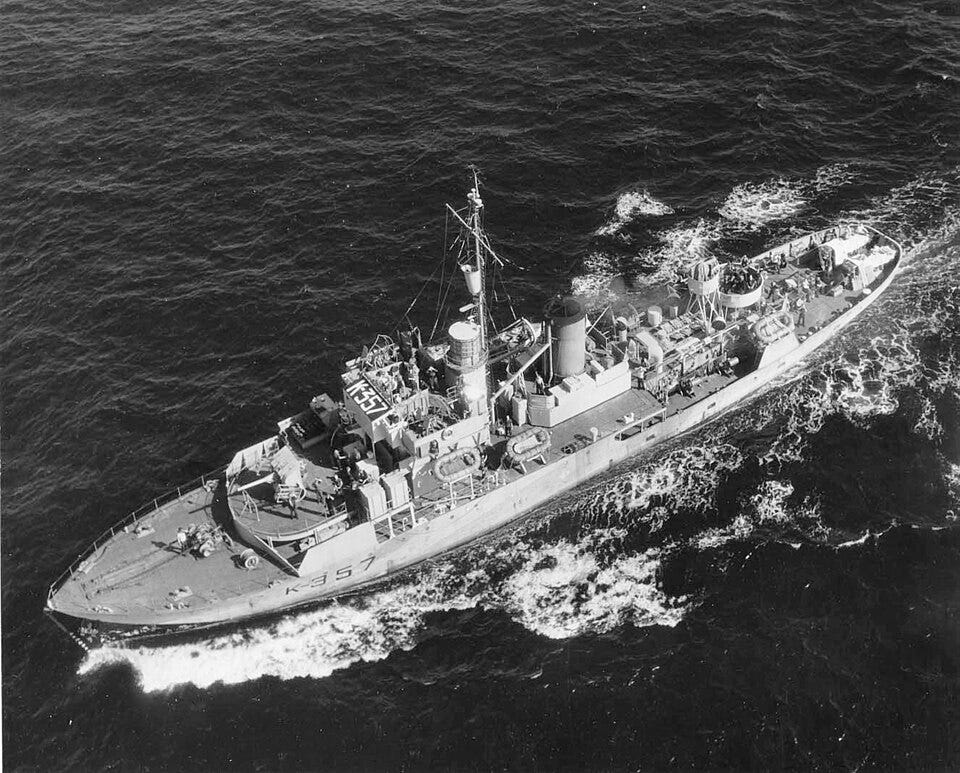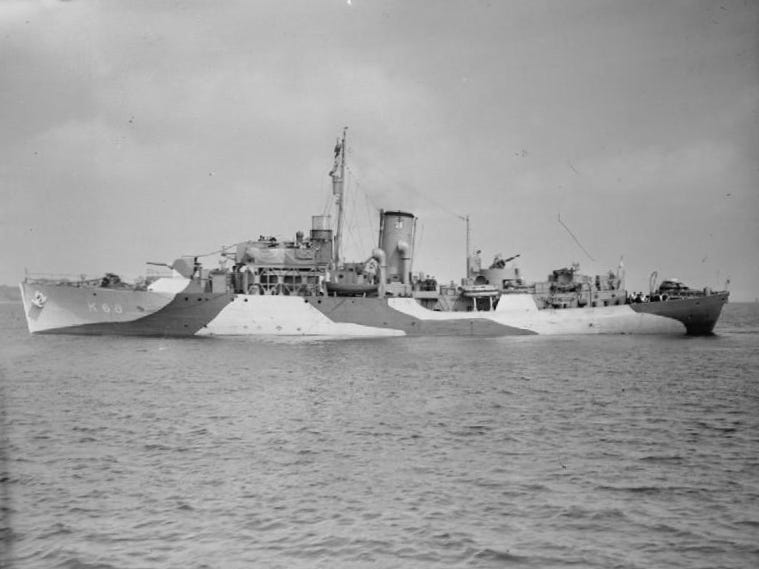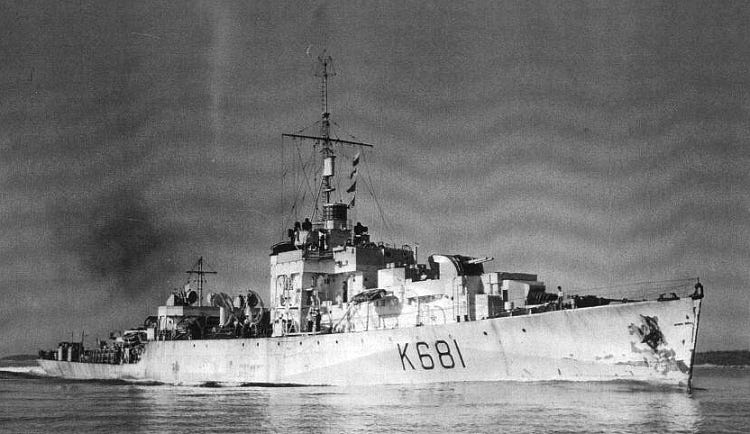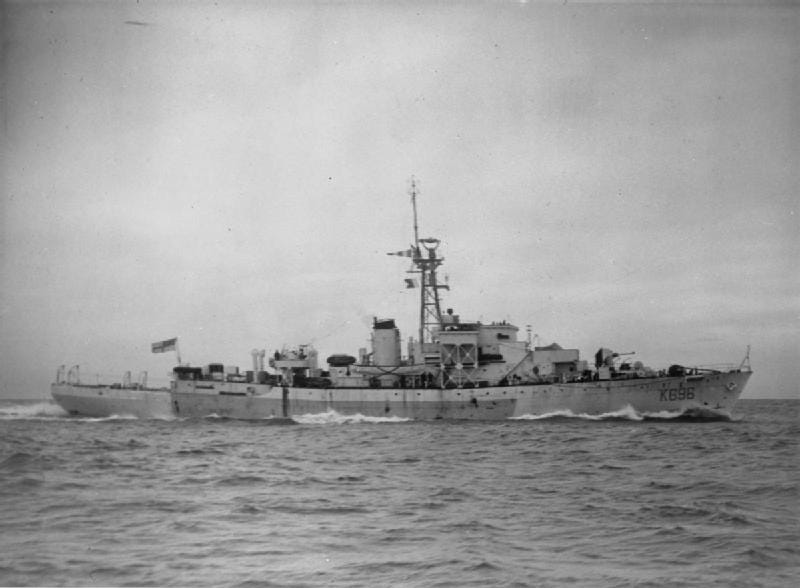And now to continue our coverage of the convoy escorts in the north Atlantic during World War II, we now reach one of the famous classes of escort ships.
The Hunt Class Destroyer Escort*.
(86 completed. Introduced into Service 1939. Approximately 1,140 tons. Two steam turbines, 26 knots on 2 steam turbines at 9,000 shp.)
The Hunt class was the first class of destroyer escorts of the Royal Navy. The first vessels were ordered in early 1939 and the class saw extensive service during the Second World War.
The Royal Navy had identified the need for two types of destroyers: larger vessels with heavy gun torpedo arm movement for fleet work and another type for escort duties.
Although the old fleet destroyers could be allocated escort work they were unsuitable for the task and new construction was required to replace them. Fleet destroyers were designed for speed and their machinery was inefficient at convoy speeds, reducing their range. Their shape made them poor sea boats at low speed, also exaggerated by additional equipment on the superstructure. Modifications were needed to ease these problems.
The Hunt class escort destroyers abandoned the heavy armament and some of the speed of the fleet type to reduce unit cost and better suit mass production and the prevailing operational conditions.
The Hunts were modelled on the 1938 escort sloop HMS Bitten, it displaced 1,190 tonnes with 3,300 shiphorse power steam turbines for a speed of approximately 19 kn. Their primary armament was three twin 4-inch Mk XVI quick firing mounts. They were constructed to admiralty standards, as were contemporary destroyers, unlike the frigates which conformed much closely to mercantile practice.
The initial first subclass of Hunts were known as the type 1, they would turn out be of too short a range for open ocean work being restricted to the North Sea and the Mediterranean Sea. Later classes were longer with increased displacement resolved this problem.
The Hunt class was a very satisfactory design, but it's displacement was found to be a limiting factor in wartime with regards to any major modifications.
The Flower Class Corvette.
_(294 completed. Introduced into Service in 1940. Approximately 940 tons. Two boilers one triple expansion engine, 16 knots on 2,750 shp.)
_
A corvette is a small warship. It is traditionally the smallest class of vessel considered to be a proper (or "rated") warship. The warship class above the corvette is that of the frigate, while the class below was historically that of the sloop-of-war.
The word "corvette" is first found in Middle French, a diminutive of the Dutch word corf, meaning a "basket", from the Latin corbis.
The modern corvette appeared during World War II as an easily-built patrol and convoy escort vessel.
The famous Flower class Corvette design was a class of 294 vessels specifically designed as anti-submarine convoy escorts.
Most served in World War II with the Royal Navy and the Royal Canadian Navy, however several vessels that were built in Canada, were transferred to the United States Navy under the lend lease program. Most of the Corvettes transferred to the US Navy were actually crewed and operated by the US Coast Guard.
In the months leading up to World War II saw the Royal Navy return to the concept of a small escort warship being used in the shipping protection role.
There are two distinct groups of vessels in this class: the original Flower class of 225 vessels and a modified Flower class which followed with a further 69 vessels built from 1940 onward. The modified flowers were slightly larger and better armed.
One particular concern was the need to protect shipping of the East Coast of Britain. What was needed with something larger and faster than trawlers but still cheap enough to be built in large numbers, preferably at small merchant shipyards as the large yards were already busy.
To meet this requirement, the Smith Dock company, a specialist in the design and building of fishing vessels offered to develop a small escort based around it's 700 ton 16 knot whaler design. They were intended as small convoy escort ships that could be produced quickly and cheaply and in large numbers. Despite the naval planners intentions that they be deployed for coastal convoy work, their long range meant that they became the mainstay of the mid-ocean escort convoy protection force during the first half of the war.
The Flower class became an essential resource for North Atlantic convoy protection until larger vessels such as destroy escorts and frigates could be produced in sufficient numbers. A simple design of a flower class using parts and techniques from the construction of merchant shipping meant that they could be constructed in small commercial shipyards all over the United Kingdom orn Canada, where larger or more sophisticated warships could not be built. Additionally the use of commercial triple expansion machinery instead of steam turbines meant that the members of the Royal Navy reserve volunteer service that were manning the corvettes would already be familiar with the operations of the machinery. (Steam turbines were rare in merchant ships at this time, the predominant power plant was the triple expansion steam reciprocating engine.)
Flower class vessels were slow for a warship, with a maximum speed of 16 kn. They were also very lightly armed as they were intended solely for anti-submarine warfare, this was later considered to be a problem that was resolved with the modified second class being fitted with a limited anti-aircraft gun armament.
The original Flower class were fitted with a 4 inch gun on the bow, depth charge racks carrying 40 charges on the stern, a mine sweeping winch and a two-pounder anti-aircraft gun over the engine room. Due to shortages the two-pounder gun was frequently replaced with machine guns. This would've left the ships very vulnerable to air attack in their vital role of coastal convoy escorts and patrol in the North Sea. The long range endurance of the vessel coupled with early wartime shortages of larger escort vessels, resulted in flowers being tasked to convoy escort work where Luftwaffe aircraft were rarely encountered.
Underwater detection capability was provided by a fixed ASDIC/SONAR system. Later High Frequency Direction Finding systems were added along with various radar systems, such as the Type 271, which proved particularly effective in the low visibility conditions, frequently encountered, in the North Atlantic.
The Flower class having been designed for inshore patrol and harbour defence required numerous minor modifications when the Allied Naves began to use them as transatlantic convoy escorts. The small ships could be supported by any small dockyard or naval station, so many ships resulted in receiving a variety of weapon systems and design modifications depending on when aware they were being fitted, there's really no such thing as a standard Flower class corvette.
Modifications.
Some examples of the many modifications that vessels in the class received were The removal of the heavy sweeping gear that was not required for deep sea escort work and to improve range. Extra depth charge racks were also fitted at the stern, increasing that depth charge storage from 40 to 110 units. Hedgehog antisubmarine gear was fitted to enable remote attacks while keeping ASDIC contact. Surface radar was also fitted, being mounted above the bridge. They also received increased flare at the bow in order to improve their sea keeping performance out on the open ocean. For some vessels additional 20 mm anti-aircraft guns were fitted, usually two on the bridge wings but sometimes as many as six mountings spread out around the ship, Which ships received which modifications generally depended on the theatre of operations.
Service on the Flowers in the North Atlantic was typically cold, wet, monotonous and uncomfortable. Every dive of the forecastle into an incoming wave was followed by a cascade of water into the well deck midships. Action stations were drenched with spray as water entered living spaces through hatches for access to ammunition magazines. Interior decks were constantly wet and condensation constantly dripped from the overheads decks. The toilet was drained by a straight pipe to the ocean and a reverse flow of this icy North Atlantic would clean the backside of those using it during rough weather. By 1945 these corvettes were carrying twice as many crewman as anticipated in the original design.
Man slept on lockers or table tops or in any dark place that offered a little warmth. The inability to store perishable food meant reliance on preserved food such as corn beef and powdered potato for all meals.
The Flowers were nicknamed the Pekingese of the ocean. They had a reputation of having poor sea handing characteristics, most often rolling in heavy seas, it was said they would roll on wet grass. Many crew had to suffer motion sickness for a few weeks until they became acclimatised to shipboard life. Although poor in their sea handling characteristics, the Flowers were extremely seaworthy, no sailor was ever lost overboard from a Flower during World War II.
Of the class, 36 were lost during World War II, many due to enemy action, some due to collisions with other warships and merchant ships. Of the vessels lost to enemy action, 22 were torpedoed by U-boats, five to mines and four were sunk by aircraft.
The Flower class corvettes were accredited with the sinking of 47 German and Italian submarines. Construction of the Flower class vessels were superseded towards the end of the war by other designs, as larger shipyards concentrated on River class frigates and the smaller yards on improved Castle class corvette designs. The Flower class represented fully half of all Allied convoy escort vessels in the North Atlantic during World War II.
The River Class Frigate.
(151 completed. Introduced into Service in 1942. Approximately 1392 tons displacement. Two boilers two triple expansion engines (two of the Flower class units), 20 knots on 5,500 shp.)
The River class was a class of 151 vessels launched between 1941 and 1944 for use as anti-convoy escorts in the North Atlantic.
The majority served with both Royal Navy and the Royal Canadian Navy. The River class ships were designed by the Smith Dock company to have the endurance and anti-submarine capabilities of the Black Swan class, whilst also being quick and cheap to build in civilian dockyards, using the machinery and techniques pioneered in the building of the Flower class corvettes.
Improvements over the Flower design included better accommodation. The twin sets of engines gave only a 3 kn speed increase but extended the range of the ship to nearly double that of the Flower at 13,000 km at 12 kn. Other changes that were applied to the design were made to improve the capability to combat U-boats, including a twin 4-inch mount forward and 12-pounder mount at the stern. Fifteen Canadian frigates would initially be fitted with single forward guns ,but with the exception of one they all eventually upgraded to the twin mount. For underwater targets the class were equipped with the hedgehog anti-submarine mortar, debt charge rails and four side mounted depth charge throwers for a 10 charge pattern.
River class frigates were the first Royal Navy and Royal Canadian Navy warships to carry the advanced 147B SWORD horizontal fan beam active SONAR transmitter, in addition to its regular ASDIC fitout. This allow the ship to maintain contact with targets even while firing, unless the target was struck. Better radar and radio direction finding equipment improved the ability to find and track enemy submarines compared with the previous classes. The class design was used as the basis for the United States Navy Tacoma class, and the hull design was later elaborated into the Loch class and subsequently the Bay class.
The Castle Class Corvette
(44 completed. Introduced into Service in 1943. Approximately 1100 tons. One boiler & one triple expansion engine, 16 knots on 2,750 shp.)
By mid 1939 the order book for the Flower class corvettes stood at 175 units. As noted above they were designed to be built in large numbers in small shipyards with many common components, which were not in short supply so as to not compete with other warships for construction resources. However it was already being realised that the Flowers were going to be used for open ocean escort missions in the North Atlantic for which they lacked speed, endurance, and habitability.
This resulted in the beginning of the design for an open ocean escort in November 1940, a design that became the River class frigate.
The River class was both too expensive to produce at the required rate and needed larger slipways than were available. In response to this the Loch class frigate was developed in late 1942, it was developed from the River class and optimised for pre-fabricated construction.
The Castle class was developed from a proposal by the Smith Dock company for a stretched Flower. The result with a scaled down version of the Loch class for shipyards that only built Corvettes using traditional construction methods.
The design was approved in 1943 with 98 Castles being ordered from yards in the UK and Canada. Numerous ships in the class were later cancelled with Canada receiving 12 British built ships instead.
The Castle class resembled later Flowers with an extended forecastle and mast behind the bridge, they were 135 tons heavier and 47 feet longer. They featured an improved hull form which in combination with the increased length made the class at least half an knot faster than the Flower, despite using the same engine. The Castle class also had a single screw
Construction used mainly traditional methods with as much welding as possible, scantling was based on the Flowers, but lightened in some areas. The wireless office, the radar office and the lattice mask were built as pre-fabricated units.
In place of the breach loading 4-inch main gun the Castles had a new quick firing 4-inch high angle/low angle mounting that could be used against aircraft as well as against surface targets such as submarines.
Well, that's enough for this week. Next week we should be able to finish the Canadian and Royal Navy escort overview and we can then cover the US Navy's contribution with some side quests into some of the technology that was being used.
Hope to see you then.....








